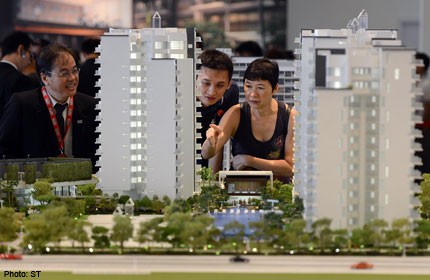Consider dual-key apartments in BTO flat


SINGAPORE - The reason the Government acted on dual-key executive condominium (EC) units is because they are sometimes not used for what they were intended.
Minister for National Development Khaw Boon Wan reiterated this in Parliament on Monday.
Housing agents The New Paper spoke to agreed.
The two-door apartments were originally planned for multi-generational families.
The studio unit, which adjoins the main unit, has its own entrance, kitchen and bathroom.
Elderly parents can live in the studio while the main unit can be occupied by a young couple with kids.
This allows the best of both worlds - grandparents to look after the kids and privacy for both households.
But some home owners bought these units as a form of investment and a way to offset part of their mortgage by renting out the adjoining studio unit, real estate agents said.
The studio can be rented out as it is considered a room in the apartment though it has its own door.
At the most recent EC launch of CityLife@Tampines, such units were sold out within the first two days, said Global Property Strategic Alliance's senior group director Angeline Ang.
A real estate agent who declined to be named said developers had marketed dual-key EC units as investments with good rental yield.
They said that depending on the location, these studio apartments could command a monthly rent of between $1,200 and $2,000.
To plug this, the Government now requires buyers of dual-key EC units to be multi-generational families.
But there is a case to be made to build more of these despite the abuses, said Member of Parliament for Nee Soon GRC Lee Bee Wah.
She wants the Ministry to consider dual-key apartments in Build-to-Order (BTO) flats.
"In view of the popularity of the dual-key ECs, will the Minister consider reintroducing multi-generational new BTO flats for (those) who have large families and cannot afford ECs?" she said in Parliament on Monday.
Mr Khaw said the Ministry will look into it.
When contacted, Ms Lee said a few of her residents with children and whose parents lived with them found their current flats too small, and could not afford to buy an EC or a multi-generational flat from the resale market.
"There will be some who will abuse the system, but we cannot ignore those with genuine demand," she said.
MP for Pasir Ris-Punggol GRC Gan Thiam Poh also told The New Paper that he received similar requests from residents.
He said: "They want a bigger flat so that they can live near their parents and their parents can help to look after their kids. It makes sense.
"Such units may encourage Singaporeans to have more kids."
One way to gauge the demand for such flats is to introduce some units in upcoming BTO launches and "monitor its take-up rate", suggested Ms Lee.
"Or maybe the Government can help such families apply for flats located side-by-side," she said.
Under one roof
The Housing Board introduced multi-generational flats in late 1986 to promote extended-family living under the same roof.
These were four- or five-room units, which came with an adjoining studio apartment.
The studio apartment had its own separate entrance and came with an attached kitchenette and bathroom, but was linked by a door to the main flat.
Owners had the option of knocking down the walls separating the two units, but this required prior approval from HDB.
A total of 367 such flats were rolled out in a pilot project in Bishan, Tampines and Yishun.
Demand for such flats remained low and HDB decided to cease building them, an HDB spokesman told My Paper in an earlier report.
But they are available in the resale market.